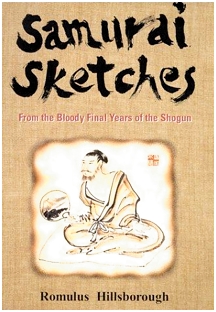
Samurai Sketches: From the Bloody Final Years of the Shogun (Ridgeback Press 2001; hardcover, $24.95)
“A portrayal of Japanese warrior life that is as deliberate, spare, disciplined, and quietly poetic as a tea ceremony.”—Kirkus Reviews
“A quiet work of mute precision that brings to life the Hagakure and those who lived by its dictates.”—Kirkus Reviews
The final years of the samurai were an age of unprecedented turmoil and bloodletting in Japan. They heralded the end of nearly three centuries of rule under the Tokugawa Shogun. The rule of law was deteriorating, assassination and murder were rampant, and inner-fighting among the warrior class embroiled the nation. After the United States forced an end of over two hundred years of Japanese isolation, two contrasting philosophies were embraced by the samurai. On one side were those who would overthrow the shogun and restore the Emperor to power. Opposing the revolutionaries were the allies of the Tokugawa Bakufu, headed by the shogun.
While the shogun’s men clashed violently with the revolutionaries, as samurai they shared with each other an allegiance to an unwritten code of honor which governed the ways they lived and died. Theirs was a stoic system of morals which condoned suicide, vengeance and, in some cases, cold-blooded murder. Samurai Sketches is, to quote author Romulus Hillsborough, “accurate portrayals of the heart and soul of the samurai, the social and political systems of whom have, like the Japanese sword, become relics of a distant age, but the likes of whose nobility shall never again be seen in this world.” In recounting what he terms “the great epic which was the dawn of modern Japan,” Hillsborough delves deeply into the psyche of the men of the samurai class. Brought to life are not merely warriors of a distant age and culture, but human beings, both good and bad, who suffer the same pangs of body and mind as all of us. Depicted are:
– The unruly swordsman with a propensity for cold-blooded murder, who is also the poet of a profoundly delicate quatrain in the face of his own imminent death.
– The executioner who prays at the scaffold for the souls of the condemned, and who performs sword “cutting tests” on their bodies.
– The assassin who dies by his own sword rather than violate his self-imposed code of honor.
– The brilliant commissioner of the shogun’s navy who, refusing to draw his blade, dominates his adversaries by sheer strength of mind.
– The notorious commander of the shogun’s most dreaded police corps who is captured for execution by the new Imperial government.
– The expert swordsman, charismatic revolutionary leader, meticulous planner of cold-blooded murder, and weaver of terror in the hearts of men.
– Japan’s most beloved samurai who was assassinated shortly after accomplishing his vow to overthrow the Bakufu.
– The quintessential samurai, magnanimous revolutionary leader, and commander-in-chief of the forces of the new Imperial government.
In each of these thirty historical sketches and vignettes, Hillsborough wields his vivid literary style to bring his readers gripping accounts of real events and people from the final bloody days of the samurai, never before presented in the English language.
